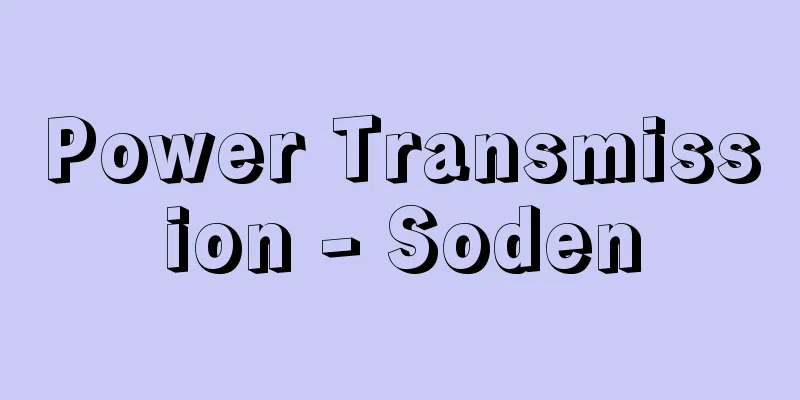Power Transmission - Soden

|
This refers to the transportation of electricity generated at power plants to consumers such as factories and ordinary homes. [Naoyuki Uchida] Current/VoltageThe voltage generated by the generators of power plants is generally 10 to 20 kilovolts. Considering the economic design and safety of the equipment, this level of voltage is preferable. The output of generators has been gradually increased due to the development of analytical technology and the progress of manufacturing technology, and as of 2012, the largest ones are a nuclear power plant with 1.38 million kilowatts (Hamaoka Unit 5, which has been out of service since May 2011 for regular inspection), a thermal power plant with 1.05 million kilowatts (Tachibanawan Thermal Power Plant Units 1 and 2), and a hydroelectric power plant with 470,000 kilowatts (Kannagawa Thermal Power Plant Units 1 and 2). When transporting such large amounts of electricity over long distances, it is necessary to minimize losses along the way, so the voltage is converted to a higher voltage by a transformer connected to the generator. Therefore, ultra-high voltage transmission lines such as 500 kilovolts and 275 kilovolts are used to transport electricity from power plants built at apogees to overcrowded areas (consumers). The current and voltage of the power system are three-phase AC, and so-called double-circuit towers are usually used, with two circuits installed on one tower. When transmitting particularly large amounts of power, multi-conductor transmission lines combining multiple conductors are used. These multi-conductor transmission lines have excellent performance against corona (a partial discharge phenomenon that can cause adverse effects such as communication failure), which is often a problem in high-voltage systems. From a thermal standpoint, the transportable power of such high-power transmission lines can exceed 10 million kilowatts even in the case of a single circuit in a 500-kilovolt system. [Naoyuki Uchida] SubstationThere are various types of substations, such as (1) large-capacity substations that collect large amounts of power from power plants and send it to overcrowded areas, (2) medium-capacity substations that supply power to relatively large consumers, and (3) small-capacity substations that supply power to general consumers. The power equipment in a substation consists of a busbar that collects power from the transmission line, a transformer to convert it to an appropriate voltage, a circuit breaker, reactors and capacitors for voltage adjustment, various control devices, and protective relay devices. Most substations are built outdoors, away from overcrowded areas due to land availability and worsening environmental conditions, but indoor and underground types, which are smaller and have better noise levels, are often used in overcrowded areas. In addition, from the standpoints of (1) improving reliability, (2) reducing losses, (3) reducing maintenance labor, and (4) economy, the simplification and unitization of circuit configurations, the adoption of highly reliable and compact equipment, and thorough labor-saving and automation are being promoted. [Naoyuki Uchida] Power LinesA transmission line is a line between a power plant and a substation or between substations, while a line between a small-capacity substation and a consumer is called a distribution line. Transmission lines connected to consumers can be either overhead or underground. Overhead transmission lines are held in place by the arms of steel towers. Underground transmission lines can be laid directly buried, in a conduit, or through a tunnel. Types of underground transmission lines are classified into paper cables (solid cables, gas pressure cables, oil-filled cables, pipe cables), rubber/plastic cables (rubber-based cables such as butyl rubber and natural rubber, plastic cables such as CV cables), new transmission methods (air-filled conduit transmission, superconducting transmission, etc.), etc. Electricity is supplied to relatively large consumers from medium-capacity substations via overhead or underground lines, while general consumers are supplied from small-capacity substations (called distribution substations). The voltage in these cases is usually 6 kilovolts, and these are called 6-kilovolt distribution lines. In highly densely populated areas, a large amount of power needs to be supplied, so new methods such as supplying electricity via 20-kilovolt underground lines are also being adopted. [Naoyuki Uchida] Protection and AdjustmentSince power transmission lines usually transport large amounts of electricity over long distances, they must be efficient and prevent power outages. The transmission areas pass through mountains, rivers, and fields, and are constantly exposed to severe natural threats such as storms, floods, snowstorms, and lightning, so they must be able to withstand these. Since power distribution lines are constructed in areas where houses are densely populated, safety must come first, and they must be designed in a way that harmonizes with the city's transportation, telegraph, telephone, gas, water, and other facilities, as well as the aesthetics of the city. The power system is a combination of these transmission and distribution systems, but to keep it stable, it is necessary to carefully adjust the frequency, voltage, and power flow. For example, frequency adjustment involves quickly adjusting the output of each generator widely distributed throughout the system in response to the ever-changing load fluctuations of consumers. It is quite difficult to adequately respond to sudden increases in load in the morning and sudden changes in load during lunch breaks. In Japan, the frequency is divided into 50 Hz on the east side and 60 Hz on the west side of the Fuji River, and these systems are connected at frequency converter stations (Sakuma, Shinshinano, Higashishimizu). Voltage adjustment is also performed by appropriately controlling the transformer taps and each voltage adjustment device (reactor and capacitor). In most cases, both frequency adjustment and voltage adjustment are performed by automatic devices. In the unlikely event that an accident occurs on a transmission line, protective relay devices installed at each power facility will quickly detect whether an accident has occurred (generally within about 0.05 seconds) and disconnect the facility where the accident occurred from the power system. As described above, the power system (of which transmission is the core) must maintain a wide range of power facilities under constant physical conditions, so the planning, construction, operation and maintenance of the facilities must be carried out with constant attention to overall coordination. [Naoyuki Uchida] [Reference] | | | | |Power | | |©Shogakukan "> Power transmission system diagram Source: Shogakukan Encyclopedia Nipponica About Encyclopedia Nipponica Information | Legend |
|
発電所で発生する電力を、工場や一般家庭などの需要家に輸送することをいう。 [内田直之] 電流・電圧発電所の発電機の発生する電圧はおおむね10キロ~20キロボルトである。機器の経済設計、安全性などを考慮すると、この程度の電圧が好ましい。発電機の出力は、解析技術の開発、製造技術の進歩などにより逐次大型化し、2012年(平成24)時点で最大のものとしては、原子力機138万キロワット(浜岡5号機。2011年5月以降は定期検査のため停止)、火力機105万キロワット(橘湾(たちばなわん)火力1号機、2号機)、水力機47万キロワット(神流川(かんながわ)1号機、2号機)などとなっている。このような大電力を長距離にわたって輸送する場合は、途中のロスを極力少なくする必要があるため、発電機に接続する変圧器によって高い電圧に変換している。したがって、遠地点に建設された発電所から過密地域(需要家)までの電力輸送は500キロボルト、275キロボルトなど超高圧送電線が用いられる。 電力系統の電流・電圧は三相交流であり、通常は一つの鉄塔に2回線が設置されるいわゆる2回線鉄塔が用いられる。とくに大電力を輸送する場合は、複数の導体を組み合わせた多導体送電線が用いられる。この多導体送電線は、とくに高い電圧系統でしばしば問題になるコロナ(部分的な放電現象で通信障害などの悪影響のもととなる)に対しても優れた性能を有する。このような大電力用送電線の輸送可能電力は、熱的な面からみて500キロボルト系統においては、1回線の場合でも1000万キロワットを超えるまでに達している。 [内田直之] 変電所変電所は、(1)発電所からの大電力を収集し、さらに過密地域へと送り出す大容量変電所、(2)比較的大きな需要家に電力を供給するための中容量変電所、(3)一般需要家に電力を供給する小容量変電所、など種々の形態がある。変電所における電力設備は、電力を送電線からいったん収集する母線、適切な電圧に変換するための変圧器、遮断器、電圧調整のためのリアクトルやコンデンサー、各種制御装置、保護リレー装置などから構成される。用地事情、環境条件の悪化などにより過密地域から離れた所に建設される変電所は屋外式が多いが、過密地域になるにしたがって縮小化や、騒音などの面で優れた屋内式、地下式が多く採用されている。このほか、(1)信頼度向上、(2)損失の軽減、(3)保守の省力化、(4)経済性などの面から、回路構成の簡素化・ユニット化、高信頼度でコンパクトな機器の採用、省力化・自動化の徹底などを推進している。 [内田直之] 送電線送電線とは、発電所と変電所の間または変電所相互間の線路をいい、小容量変電所と需要家の間は配電線という。需要家へ連接する送電線には、架空送電線の場合と地中送電線の場合がある。架空送電線は鉄塔のアームによって送電線を保持するものである。地中送電線は敷設方法として直埋式、管路式、洞道式などがある。地中送電線の種類としては、紙ケーブル(ソリッドケーブル、ガス圧ケーブル、油入りケーブル、パイプ型ケーブル)、ゴム・プラスチックケーブル(ゴム系ケーブルとしてブチルゴム、天然ゴムなど、プラスチック系ケーブルとしてCVケーブルなど)、新送電方式(管路気中送電、超伝導送電など)などに分類される。 比較的大きな需要家への電力供給は、中容量変電所から架空送電線や地中送電線を経て送電されるが、一般需要家に対しては小容量変電所(配電用変電所と称している)から供給している。この場合の電圧は6キロボルトが多く、6キロボルト配電線と称している。超過密地域ではかなりの大電力を供給する必要があるので、20キロボルト地中送電線で供給するなど新しい方式も採用されている。 [内田直之] 保護・調整送電線は普通大電力を長距離に輸送するものであるから、停電のないように努めるとともに効率的でなければならない。送電区間には、山、川、野原などがあって、暴風雨、洪水、吹雪(ふぶき)、雷などつねに厳しい自然の脅威を受けるから、これらに十分対抗できるようにする必要がある。配電線は人家の密集している所に建設されるものであるから、安全を第一とし、都市の交通、電信、電話、ガス、水道などの施設、都市の美観などと調和のとれた形態とする必要がある。 電力系統とは、このような送電系統、配電系統を合成したものであるが、つねに安定した状態に維持するためには、周波数、電圧、電力の流れなどをきめ細かに調整しなければならない。たとえば、周波数調整は時々刻々変化する需要家の負荷変動に対応して、全系統に広く散在する各発電機の出力を速やかに加減することとなる。朝の負荷の急上昇、昼休みの急激な負荷変化などに十分対応することはかなり困難である。この周波数は日本の場合、富士川を境にして東側は50ヘルツ、西側は60ヘルツに分かれており、これらの系統は周波数変換所(佐久間(さくま)、新信濃(しんしなの)、東清水(ひがししみず))で接続されている。また、電圧調整は変圧器のタップ、各電圧調整装置(リアクトルやコンデンサー)を適切に制御して行うこととなる。周波数調整、電圧調整とも、ほとんどの場合は自動装置で行われている。万一、送電線に事故が発生した場合は、おのおのの電力設備に設置している保護リレー装置により、事故発生の有無を速やかに(一般には0.05秒程度で)検出して、事故発生設備を電力系統から切り離すようにしている。以上のように、電力系統(送電はそのうちの中心となる)は、広い範囲にわたる電力設備をつねに一定の物理的条件のもとに維持されなければならないので、設備の計画、建設、運転、保守は全体の協調につねに留意しつつ行われている。 [内田直之] [参照項目] | | | | | | | |©Shogakukan"> 送電系統図 出典 小学館 日本大百科全書(ニッポニカ)日本大百科全書(ニッポニカ)について 情報 | 凡例 |
Recommend
Love wife somewake tatsuna
Joruri Gidayu-bushi. Historical piece. 13 acts. C...
Ethiopian Music - Ethiopian Music
The liturgical music of the Coptic Church, a sect ...
Hypochlorous acid - Hypochlorous acid (English spelling)
An oxoacid of chlorine. It exists only as an aque...
Milori blue (English spelling)
…A type of blue inorganic pigment. It was invente...
Kaminus - Kaminus
… [Hiroyuki Suzuki] [Western Chimneys] In Shakesp...
Scorpionfish (Total cap) - Scorpionfish
A general term for marine fish of the genus Scorpa...
Aurea Nana - Aurea Nana
...The horticultural variety Betzickiana cv. is o...
Ufa - Ufa (English spelling)
It is the capital of the Republic of Bashkortosta...
ginger
Also known as Hanasukusha. A perennial plant of th...
A box of 1000 ryo coins
〘Noun〙① A container used to store gold coins durin...
Conrad, Johannes
[Born] 1839 [Died] 1915 A German economist of the ...
Rhode Island
A state in New England, United States. Abbreviated...
Nikolay Gerasimovich Pomyalovskiy (English spelling)
Russian novelist. Born into a poor deacon's f...
mating type structure
…The first characteristic of the conjugation proc...
Ek, NV - Ek
In 1928, before a single talkie had been made in ...




![Sano [city] - Sano](/upload/images/67cbad798e816.webp)




